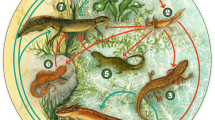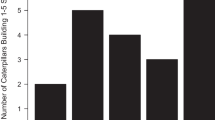Abstract
The fitness of non-feeding adult insects depends on energy accumulated during the larval stage. Larvae of the caddisfly Asynarchus nigriculus primarily feed on plant detritus, but supplement their diet with animal material obtained through cannibalism. Habitat drying constrains development in many populations of this species, and we hypothesized that cannibalism should accelerate development to facilitate timely metamorphosis. We manipulated larval diets in a field experiment by supplementing detritus with animal material, and in a laboratory experiment by varying animal material and detritus quality (conditioned vs unconditioned). We measured the effects of dietary manipulation on larval and pupal growth and development, the timing of metamorphosis, and adult fitness correlates. The results of the laboratory experiment suggest that this species can metamorphose with a detritus-only diet, but development is extremely protracted. In the field experiment, individuals with animal material in their diet had higher larval survival, shorter larval and pupal development times, and earlier emergence dates (7–10 days), than those without a supplement. This delay in emergence should have important effects on survival in natural populations where the difference between desiccation and successful emergence can be only a few days. Dietary supplementation also affected adult body mass (30–40% increase), female fecundity (30% more eggs), and proportional allocation to different adult body parts. Our results are consistent with recent growth-development models that predict coupled (earlier emergence and larger adults) rather than tradeoff responses (earlier emergence and smaller adults) to pre-threshold manipulation of larval diets. Many detritivorous aquatic insects supplement their diets with animal material, and our data provide evidence that this supplementation can have strong effects on fitness. This type of dietary supplementation should be especially important for taxa that do not feed as adults, and in temporary habitats that impose time constraints on larval development.







Similar content being viewed by others
References
Anderson NH (1976) Carnivory by an aquatic detritivore, Clistorina magnifica (Trichoptera Limnephilidae). Ecology 57:1081–1085
Anderson NH, Cargill AS (1987) Nutritional ecology of aquatic detritivorous insects. In: Slansky F, Rodriquez JG (eds) Nutritional ecology of insects, mites, spiders, and related invertebrates. Wiley, New York, pp 903–925
Arsuffi TL, Suberkropp K (1989) Selective feeding by shredders of leaf colonized stream fungi: comparison on macroinvertebrate taxa. Oecologia 79:30–37
Bergey EA, Resh VH (1994) Interactions between a stream caddisfly and the algae on its case: factors affecting algal quality. Freshw Biol 31:153–163
Berté SB, Pritchard G (1986) The life histories of Limnephilus externus Hagen, Anabolia bimaculata (Walker) and Nemotaulius hostilis (Hagen) (Trichoptera, Limnephilidae) in a pond in southern Alberta, Canada. Can J Zool 64:2348–2356
Blankenhorn WU (2000) The evolution of body size: what keeps animals small? Q Rev Biol 75:385–407
Boggs CL (1981) Nutritional and life history determinants of resource allocation in holometabolous insects. Am Nat 117:692–709
Boggs CL (1997) Dynamics of reproductive allocation from juvenile and adult feeding: radiotracer studies. Ecology 78:190–202
Bowen SH, Lutz EV, Ahlgren MO (1995) Dietary protein and energy as determinants of food quality: trophic strategies compared. Ecology 76:899–907
Choe JC, Crespi BJ (1997) The evolution of mating systems in insects and arachnids. Cambridge University Press, Cambridge
Corkum LD, Ciborowski JJH, Poulin RG (1997) Effects of emergence data and maternal size on egg development, sizes of eggs, and first-instar nymphs of a semelparous aquatic insect. Oecologia 111:69–75
Day RW, Quinn GP (1989) Comparisons of treatments after an analysis of variance in ecology. Ecol Monogr 59:433–463
Day T, Rowe L (2002) Developmental thresholds and the evolution of reaction norms for age and size at life-history transitions. Am Nat 159:339–350
Dong Q, Polis GA (1992) The dynamics of cannibalistic populations: a foraging perspective. In: Elgar MA, Crespi BJ (eds) Cannibalism: ecology and evolution among diverse taxa. Oxford University Press, New York,pp 12–37
Elgar MA, Crespi BJ (eds) (1992) Cannibalism: ecology and evolution among diverse taxa. Oxford University Press, New York
Emlen DJ (2000) Integrating development with evolution: a case study with beetle horns. Bioscience 50:403–418
Fox LR (1975) Cannibalism in natural populations. Annu Rev Ecol Syst 6:87–106
Frost PC, Elser JJ (2002) Growth responses of littoral mayflies to the phosphorus content in their food. Ecol Lett 5:232–240
Giller PS, Sangpredub N (1993) Predatory foraging behavior and activity patterns of larvae of two species of limnephilid cased caddis. Oikos 67:351–357
Graca MAS, Cressa C, Gessner MO, Feio MJ, Callies KA, Barrios C (2001) Food quality, feeding preferences, survival and growth of shredders from temperate and tropical streams. Freshw Biol 46:947–957
Hentschel BT, Emlet RB (2000) Metamorphosis of barnacle nauplii: effects of food variability and a comparison with amphibian models. Ecology 81:3495–3508
Honek A (1993) Intraspecific variation in body size and fecundity in insects: a general relationship. Oikos 66:483–492
Hopper KP, Crowley PH, Kielman D (1996) Density dependence, hatching synchrony, and within-cohort cannibalism in young dragonfly larvae. Ecology 77:191–200
Huryn AD, Wallace JB (2000) Life history and production of stream insects. Annu Rev Entomol 45:83–110
Iverson TM (1979) Laboratory energetics of larvae of Sericostoma personatum (Trichoptera). Holarctic Ecol 2:1–5
Jacobsen D, Friberg N (1995) Food preference of the trichopteran larva Anabolia nervosa from two streams with different food availability. Hydrobiologia 308:139–144
Jacobsen D, Sand-Jensen K (1994) Growth and energetics of a trichopteran larva feeding on fresh submerged and terrestrial plants. Oecologia 97:412–418
Johansson F, Stoks R, Rowe L, De Block J (2001) Life history plasticity in a damselfly: effects of combined time and biotic constraints. Ecology 82:1857–1869
Kreiter NA, Wise DA (2001) Prey availability limits fecundity and influences the movement pattern of female fishing spiders. Oceologia 127:417–424
Ludwig D, Rowe L (1990) Life-history strategies for energy gain and predator avoidance under time constraints. Am Nat 135:686–707
MacNeil C, Dick JTA, Elwood RW (1997) The trophic ecology of freshwater Gammarus spp. (Crustacea:Amphipoda): problems and perspectives concerning the functional feeding group concept. Biol Rev 72:349–364
Mihuc TB (1997) The functional trophic role of lotic primary consumers: generalist versus specialist strategies. Freshw Biol 37:455–462
Morey S, Reznick D (2000) A comparative analysis of plasticity in larval development in three species of spadefoot toads (Anura: Pelobatidae: Scaphiopus). Ecology 81:1736–1749
Nijhout HF, Emlen DH (1998) Competition among body parts in the development and evolution of insect morphology. Proc Natl Acad Sci 95:3685–3689
Nylin S, Gotthard K (1998) Plasticity in life history traits. Annu Rev Entomol 43:68–83
Parker GA, Begon M (1986) Optimal egg size and clutch size: effects of environment and maternal phenotype. Am Nat 128:573–592
Peckarsky BL, Taylor BW, McIntosh AR, McPeek MA, Lytle DA (2001)Variation in mayfly size at metamorphosis as a developmental response to risk of predation. Ecology 82:740–757
Peckarsky BL, McIntosh AR, Taylor BW, Dahl J (2002) Predator chemicals induce changes in mayfly life history traits: a whole-stream manipulation. Ecology 83:612–618
Petersson E (1996) Male load-lifting capacity and mating success in the swarming caddisfly Athripsodes cinereus. Physiol Entomol 20:66–70
Pfennig DW (1997) Kinship and cannibalism. Bioscience 47:667–675
Pfennig DW, Ho SG, Hoffman EA (1998) Pathogen transmission as a selective force against cannibalism. Anim Behav 55:1255–1261
Polis GA (1981) The evolution and dynamics of intraspecific predation. Annu Rev Ecol Syst 12:225–251
Polis GA (1988) Exploitation competition and the evolution of interference, cannibalism, and intraguild predation in age/size-structured populations. In: Ebenman B, Persson L (eds) Size-structured populations. Springer, New York Berlin Heidelberg, pp 183–202
Potvin C (1993) ANOVA: experiments in controlled environments. In: Scheiner SM, Gurevitch J (eds) Design and analysis of ecological experiments. Chapman and Hall, New York, pp 46–68
Pritchard G, Berté SB (1987) Growth and food choice by two species of limnephilid caddis larvae given natural and artificial foods. Freshw Biol 18:529–535
Richardson JML, Baker RL (1997) Effect of body size and feeding on fecundity in the damselfly Ischnura verticalis (Odonata: Coenagrionidae). Oikos 79:477–483
Rowe L, Ludwig D (1991) Size and timing of metamorphosis in complex life cycles: time constraints and variation. Ecology 72:413–427
SAS (1999) StatView, version 5.0. SAS Institute, Cary, N.C.
Scheiner SM (1993) MANOVA: multiple response variables and multispecies interactions. In: Scheiner SM, Gurevitch J (eds) Design and analysis of ecological experiments. Chapman and Hall, New York, pp 94–112
Sokolovska N, Rowe L, Johansson F (2000) Fitness and body size in mature odonates. Ecol Entomol 25:239–248
Sparks GB (1993) Competition and intraguild predation between two species of caddisfly (Trichoptera) larvae in permanent and semi-permanent high elevation ponds. B.Sc. Thesis, Allegheny College, Meadville, Pa.
Stevens DJ, Hansell MH, Monaghan P (2000) Developmental trade-offs and life histories: strategic allocation of resources in caddisflies. Proc R Soc Lond 267:104:1511–1515
Truman JW, Riddiford LM (1999) The origins of insect metamorphosis. Nature 401:447–452
Van Buskirk J (1992) Competition, cannibalism, and size class dominance in a dragonfly. Ecology 65:455–464
Wahlström E, Persson L, Diehl S, Byström P (2000) Size-dependent foraging efficiency, cannibalism, and zooplankton community structure. Oecologia 123:138-148
Webster JR, Benfield EF (1986) Vascular plant breakdown in freshwater ecosystems. Annu Rev Ecol Syst 17:567–597
Wiggins GB (1996) Larvae of the North American caddisflies (Trichoptera), 2nd edn. University of Toronto Press, Toronto
Winterbourn MJ (1971) The life histories and trophic relationships of the Trichoptera of Marion Lake, British Columbia. Can J Zool 49:623–635
Wissinger SA, Sparks GB, Rouse GL, Brown WS, Steltzer H (1996) Intraguild predation and cannibalism among larvae of detritivorous caddisflies in subalpine wetlands. Ecology 77:2421–2430
Wissinger SA, Whiteman HH, Sparks GB, Rouse GL, Brown WS (1999a) Tradeoffs between competitive superiority and vulnerability to predation in caddisflies along a permanence gradient in subalpine wetlands. Ecology 80:2102–2116
Wissinger SA, Bohonak AJ, Whiteman HH, Brown WS (1999b) Subalpine wetlands in central Colorado: habitat permanence, salamander predation, and invertebrate communities. In: Batzer DP, Rader RR, Wissinger SA (eds) Invertebrates in freshwater wetlands of North America: ecology and management. Wiley, New York, pp 757–790
Wissinger SA, Brown WS, Jannot JE (2003) Caddisfly life histories along permanence gradients in high-elevation wetlands in Colorado (USA). Freshw Biol 48:255–270
Acknowledgements
We are grateful to the Rocky Mountain Biological Laboratory and The Nature Conservancy for access to the Mexican Cut Nature Reserve. Thanks to Suzanne Kilby for field assistance. An earlier version of the manuscript was improved greatly by discussions with Bobbi Peckarsky, Jason Jannot, Sara Mattie, and the Freshwater Ecology Research Group at the University of Canterbury (especially Angus McIntosh, Michael Winterbourn, Jon Harding, Nicholas Dunn, Leanne O‘Brien, Jane Goodman, and Hans Eikaas). This study was funded by the National Science Foundation (DEB 9407856).
Author information
Authors and Affiliations
Corresponding author
Rights and permissions
About this article
Cite this article
Wissinger, S., Steinmetz, J., Alexander, J.S. et al. Larval cannibalism, time constraints, and adult fitness in caddisflies that inhabit temporary wetlands. Oecologia 138, 39–47 (2004). https://doi.org/10.1007/s00442-003-1397-y
Received:
Accepted:
Published:
Issue Date:
DOI: https://doi.org/10.1007/s00442-003-1397-y




